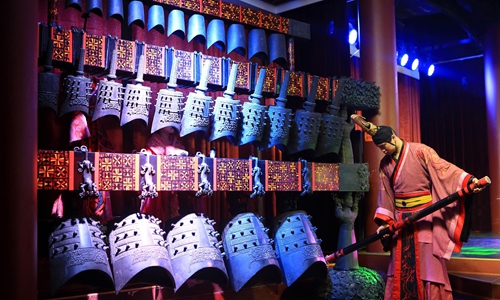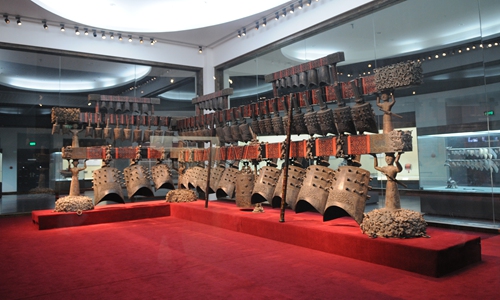From Hong Kong’s return to COVID-19, ancient Chinese instrument chimes throughout history
Source:Global Times Published: 2020/4/14 22:28:40

A performance of hime bells at the Yellow Crane Tower in Central China's Wuhan on May 21, 2018 Photo: VCG
The concert The 12 Sounds of Wuhan from renowned Chinese musician Tan Dun debuted in China on Sunday. The event was a collaboration by artists from 10 countries at three separate venues - Wuhan, Shanghai and New York - brought together through technological means such as livestreaming and 5G.
Dedicated to supporting Wuhan, at the time the epicenter of the COVID-19 outbreak in China, the world premiere of Tan's new composition was performed by the Antwerp Symphony Orchestra at the Queen Elizabeth Hall in Belgium on February 15. The musician, who has won Academy and Grammy Awards for his original piece for the film Crouching Tiger, Hidden Dragon, was determined to bring the performance home to China.
"Dear Wuhan, I promise to perform The 12 Sounds of Wuhan and Beethoven's Ode to Joy for you at home once the epidemic is over," said Tan at the end of the performance in Belgium.
Five days after Wuhan lifted its 76-day lockdown, Tan, conducting from Shanghai, led orchestras in New York and the Hubei Provincial Museum in an online performance of his work, which featured the ancient Chinese musical instrument known as bianzhong, or chime bells.
These bells are tightly tied to the history and culture of Wuhan and so have become something of a symbol of the city. Back in February, when the pandemic was at its height in Wuhan, Belgian pianist Jean-François Maljean composed a piece titled Chime of the Dawn Bells featuring this instrument to show support for the city's fight against the virus.

Chime Bells of Marquis Yi of Zeng on display at Hubei Provincial Museum in Central China's Wuhan on January 11, 2012 Photo: VCG
Ancient diplomacy
The intertwined story of chime bells and Wuhan can be traced back to the culture of Chu, an ancient kingdom that existed during the Zhou Dynasty (1046BC-221BC) and covered a region that encompassed much of today's Hubei Province and its neighboring regions in Central China. The people of Chu considered the bells a symbol of the state's power.
In 1978, a set of 65 chime bells were unearthed from the central chamber of the Tomb of Marquis Yi, who was a ruler of the state of Zeng. Zeng was among the minor states controlled by Chu. The find remains the biggest, finest and most complete set of chime bells yet to be discovered in China.
According to the inscription on one of the bells, the set was a gift from King Hui of the Chu State "to the Marquis Yi of Zeng for his perpetual use."
Fang Qin, head of the Hubei Cultural Relics and Archaeology Institute, noted that as the Chu state rose to power, it annexed many minor states other than the Zeng state, reported the Hubei Daily.
The inscription from chime bells unearthed from a tomb belonging to the Marquis Yue, the predecessor of the Marquis Yi, recorded that in 506BC, the Zeng state rescued the King of Chu when the latter was attacked by the state of Wu. This action strengthened the ties between the two.
"The Chu state didn't annex Zeng, indicating the close relationship between the two states. And because of such ties, King Hui of the Chu State ordered people to make chime bells paying tribute to the Marquis Yi of Zeng," said Wan Quanwen, deputy curator of the Hubei Provincial Museum, in an interview with Chinese news outlet thepaper.cn.
The gift hints at a good relationship between Chu and Zeng but maybe not an equal one. The bell was placed at a prominent location within the set to show respect toward Chu.
Symbol of power and friendship
Based on the year revealed in the inscription on the bell, the Marquis Yi was estimated to have died in 433BC, meaning the chime bells remained buried underground for more than 2,400 years. In addition to the intriguing history of the chime bells, what is even more striking is the fact that they still work after thousands of years.
Rated as grade-one national cultural relic, the original Chime Bells of Marquis Yi of Zeng have only been played in a performance three times in modern times. The first time was in 1978 to test the musical notes for archeological purposes. For the performance, an orchestra consisting of archeologists and musicians performed several songs and pieces of music, concluding with the famous socialist anthem "The Internationale". The orchestra is now known as the Hubei Provincial Museum Chime Bell Orchestra.
The second performance took place in 1984 to mark the 35th anniversary of the founding of the People's Republic of China. The set was taken to Beijing for a performance for Chinese leaders and ambassadors from other countries. For the third, the chime bells were used in Tan's 1997 performance of Heaven, Earth, Mankind (also known as Symphony 1997) to mark Hong Kong's return to China.
Apart from the Hubei Provincial Museum Chime Bell Orchestra, other orchestras across the country have also incorporated the instrument in their performances. These performances have been widely welcomed by the public in China and entranced international audiences when performed abroad.
Fu Qiang, deputy director of the Hubei Provincial Museum Chime Bell Orchestra, recalled their time in San Francisco during an interview with Xinhua News Agency.
Fu remembered a Chinese-American surnamed Li who came to see them perform three times during the tour. The first time, he came alone. The second time he brought a few of his friends, and the third time he brought an entire crowd of people.
"As a second generation immigrant, Mr. Li seldomly returns to visit China. He spoke to me in Chinese that wasn't very fluent, telling me that the chime bells evoked his longing for his motherland. It made him want to visit China and see the cities and its scenery," said Fu.
Global Times
Posted in: CULTURE & LEISURE